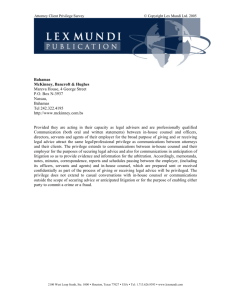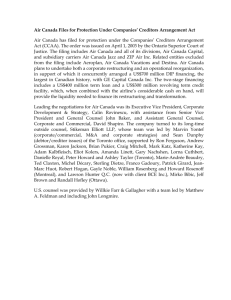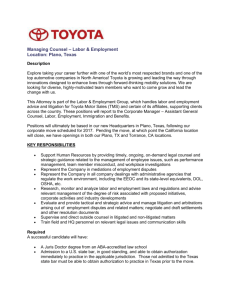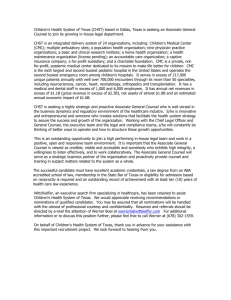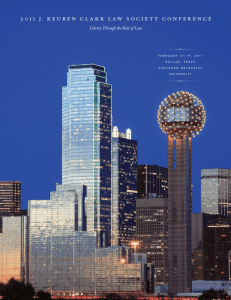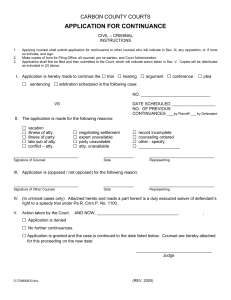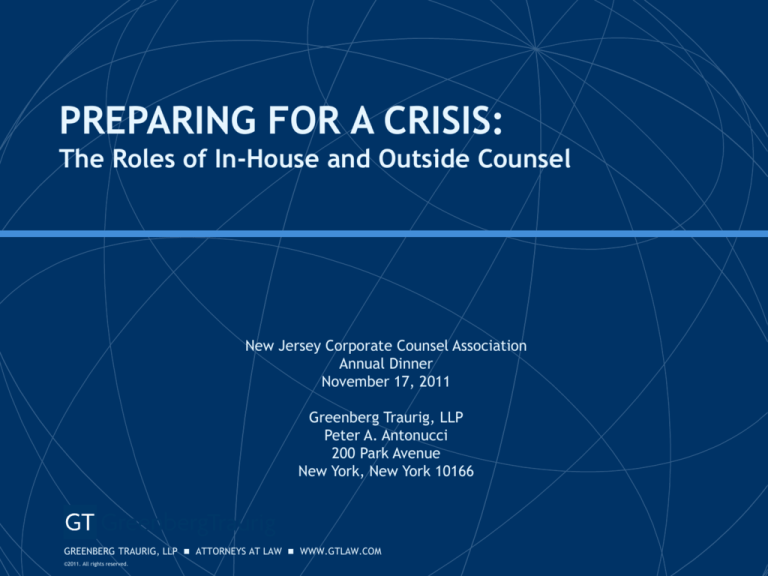
PREPARING FOR A CRISIS:
The Roles of In-House and Outside Counsel
New Jersey Corporate Counsel Association
Annual Dinner
November 17, 2011
Greenberg Traurig, LLP
Peter A. Antonucci
200 Park Avenue
New York, New York 10166
GREENBERG TRAURIG, LLP ATTORNEYS AT LAW WWW.GTLAW.COM
©2011. All rights reserved.
Preparing For A Crisis:
The Role Of Counsel
What is Crisis Management
What is a Crisis
How Do Crises Occur
Diverse and Potentially Far-Reaching Consequences of a
Crisis
Dangers of the Modern Media
How Lawyers Approach a Crisis
The Conflicts that May Arise
Public Relations Activities that Can Cause Lawyers
Concern
2
Preparing For A Crisis:
The Role Of Counsel
Legal Considerations
Think About Documents Immediately
□ Avoid Creation of Smoking Guns
□ Monitor Chatter—Internal and External
□ One Message, One Voice
□ Privilege Protections
□ Avoid Admissions or Creating Liability
□ Talk to Your Experts Right Away
□ Circle the Wagons With Your Key Witness
It is Critical that You Develop A Crisis Management Plan
Composition of a Crisis Management Team
Formulation of a Crisis Communication Plan
Realistic Options and Lessons Learned
Role of Outside Counsel
Ethical Issues Faced by In-House Counsel
Conclusion
□
3
What is Crisis Management
It is a company’s ability to be prepared for –- and respond
appropriately to –- unforeseen events which may disrupt
your business or endanger the safety or reputation of:
□
People
Company Personnel
Purchasers/Users
□
Information
□
Systems
□
Property
□
Business
4
What is a Crisis
Crisis events include:
□
Loss of Life
□
Mass product failure
□
Technology failures
□
Major infrastructure failure
□
Natural disasters or fires
□
SEC violations
□
Leadership failures
□
Work place violence
□
Corporate governance
On average, a large company is hit by a crisis once every
seven years.
5
How Do Crises Occur
Product recalls due to safety issues
Attacks by a consumer advocacy group
A former employee turns whistleblower
The filing of a high-profile lawsuit
Executives are indicted
Restatement of earnings
New legislation is proposed that threatens your industry
A serious injury involving your product with media
attention
Federal or state enforcement action
6
Diverse and Potentially Far-Reaching
Consequences of a Crisis
The consequences of a crisis can be far and wide and can
lead to devastating results. What happens or is done on
one front will impact what happens on another.
□
Litigation (in every
form and any forum)
□
The Investment
Community
□
Law Enforcement
□
The Marketplace
□
Regulatory
□
The Press
□
Legislative
□
Business Partners
□
Employees
7
Dangers of Modern Media
Plaintiff’s attorneys, consumer groups and “citizen
journalists” may mask their biases by appearing to be
legitimate news outlets.
Reporters rarely have time to delve into the science or
medicine when working on deadline. They may prefer a
pre-packaged report and run with it, without time to
thoroughly fact-check it.
Social media can allow well-meaning employees to
accidentally make confidential information about a
company’s internal response permanently public.
□
Twitter, Facebook, MySpace, LinkedIn, Blogs, etc.
□
Nothing is easily removed from the internet.
8
How Lawyers Approach a Crisis
Assume every press release or public statement your
company issues now will be an exhibit in future litigation.
All public statements, including those by executives who
may have no official authority to speak for or bind the
company, can also be considered admissions of
wrongdoing.
Speaking publicly about a matter that may be the subject
of future litigation is rarely advantageous to the future
litigant.
9
How Lawyers Approach a Crisis
Conduct and complete a thorough internal investigation
before taking positions that may bind the company in
future litigation.
Protecting Attorney-Client Privilege is paramount, and
requires attorneys to be involved in all internal
investigations and decisions about any statements or
actions.
Make sure key employees are all on the same page about
what they are saying and what they are hearing on the
ground.
10
The Conflicts that May Arise
Weigh the desire to fully investigate and collect the facts,
versus “getting in front of the story” quickly.
Carefully consider what a company says publicly to avoid
admissions, but crises change constantly and may require
“rapid response.”
Spin is an art, but if it seems misleading it can negatively
impact a company’s appearance to jurors, regulators,
lawmakers and the public.
Lawyers want only to protect their clients’ interests in
future litigation. Executives are motivated by business
concerns: damage to the brand, decreased sales,
plummeting stock price.
11
Public Relations Activities that Can Cause
Lawyers Concern
Common Mistakes
□
Trying to control the media’s coverage by giving the media
information to report that is favorable to the company’s
position, but not always complete.
□
Attempting to downplay a story’s significance, in the hope the
media and public are quickly distracted, even in situations
where the allegations are serious.
□
To avoid the appearance of uncertainty, not waiting for a
thorough investigation to be complete before the company
makes a public statement.
12
Legal Considerations
Think About Documents Immediately
□
□
□
Avoid Creation of “Smoking Guns”
□
Get a Sense of What Has Already Been Created & Now Cannot Be
Destroyed
Document Retention Policy: Have One Before A Crisis Hits
Litigation Hold Memorandum As Soon As Litigation Appears
Reasonably Likely
Have Key Employees Think Strategically About What They Put
Into All Documents
Monitor Chatter: Internal and External
□
□
□
See What Your Employees Are Emailing About the Crisis, Even
Casually, to One Another
Employee Social Media Usage—Monitor or Block?
Google Alerts & News/Media Monitoring
13
Legal Considerations
One Message, One Voice
□
□
Privilege Protections
□
□
Designate One Spokesperson And Create Cohesive Talking Points.
Every Inquiry May Be Media In Disguise—Advise All Employees.
Involve Counsel In Deliberations and Drafting For Maximum
Protection.
Label All Documents Carefully To Ensure Protection.
Avoid Admissions or Creating Liability
□
□
Any Statement May Constitute An Admission of
Wrongdoing/Liability.
In Rare Cases, Public Statements Can Lead To Criminal Liability:
InterMune CEO Steve Harkonen Was Tried & Convicted of Wire
Fraud Because of a Press Release.
14
Legal Considerations
Talk To Your Experts Right Away
□
□
Determine Your Internal And External Experts And Get Them On
Board And Involved Early.
Involve Counsel Where Possible For Consultants You Do Not
Intend To Have Testify, To Bolster Work Product Protections.
“Circle the Wagons”—Future Witnesses
□
□
□
□
Interview The Employees Who May Be Key Witnesses Someday.
Record Their Recollections While Fresh And Ensure Consistency.
Make Sure They Are Particularly Aware of the Importance of
Their Documents and Communications.
Respond To Them and Guide Them Early In A Crisis.
15
It is Critical that Every Responsible Company
Develop a Crisis Management Plan
A Crisis Management Plan will allow a company to respond
more effectively to unforeseen situations while:
□
Minimizing the loss of life
□
Maximizing response efforts
□
Maximizing recovery efforts
□
Maximizing company’s reputation
□
Minimizing business interruptions
16
Composition of a Crisis Management Team
Typically, a well-positioned company has a Crisis
Management Team composed of various elements of the
organization including:
□
Management
□
Legal
□
Operations
□
IT
□
Public Relations/Corporate Communications
□
Etc.
The Team is a formal organization within the structure of
the Company.
The Team maintains the ability to speak for the
corporation in times of crisis.
17
Formulation of a Crisis Communication
Plan
Allows an organization to communicate effectively when
an emergency occurs
□
Easy to read; easily updateable
□
Technology-friendly involving multiple ways for the organization
to communicate during times of crisis
□
Uses multiple means of communication (telephone, cell phone,
pagers, black berries, e-mails, etc.)
□
Test, test and retest
18
Role of Outside Counsel
Triage
Objective risk assessment
Ascertaining local rules/procedures/customs in locales
where the company operates
Identification and selection of local, and specialized,
counsel
Conducting the fact investigation, including interviewing
witnesses and pulling together documents
Protecting privileges and confidential or proprietary
information
Identification and selection of potential experts and other
outside assets
19
Role of Outside Counsel Cont’d
Formulating practical strategy consistent with a realistic
assessment of how a crisis is likely to unfold
Provide expertise on lessons learned from other crises
Assistance in identification and training of spokesperson(s)
Input and coordination in mapping out corporate
communications strategy, including working with in-house
and outside media experts
Making certain public responses, corporate disclosures,
and litigation defense are accurate and consistent
Coordinating expert assistance to test factual, tactical
and/or substantive assumptions
20
Role of Outside Counsel Cont’d
Assessing disclosure obligations (internal and external)
Conducting an insurance evaluation and tending to
provision of notice to all applicable insurers
Assessing potential conflicts of interest
Preserving and making the record (an on-going process)
Making certain all critical components of the company are
on the same page, including management, legal, corporate
communications, marketing, manufacturing, regional
offices, international offices, and so on, once strategy is
agreed upon.
21
Ethical Issues Faced by In-House Counsel
As in-house counsel, whom do you represent?
□
Hypothetical crisis: While the interests of the corporation and its
management are typically aligned, disagreement among or
misconduct by the principals or management of an entity creates
divergent goals. For example, a senior member of management
establishes an off-balance sheet transaction, which ultimately
requires a restatement of corporate earnings, putting the entire
corporation at risk.
□
Issue: Is the duty of in-counsel to the individual or to the
corporation? Can in-house counsel effectively represent the
individual and the corporation? What are the dangers of the
dual representation?
22
Ethical Issues: Representation of the
Entity and the Individual
May in-house counsel represent the individual and the
corporation?
□
RPC 1.13 suggests that the engagement of an attorney by a
corporation does not necessitate that the attorney also
represents those individuals affiliated with the entity.
□
However, RPC 1.13 does not expressly prohibit an attorney from
representing both.
23
Ethical Issues: Representation of the
Entity and the Individual, cont’d
What must in-house counsel do upon discovery of the offbalance sheet transaction?
According to RPC 1.13, if in-house counsel discovers
misconduct such as insider trading, s/he must:
□
□
□
□
Ask the offender to reconsider his or her actions
Advise the corporation that a secondary legal opinion should be
sought
Advise the highest member of the organization of the
misconduct
If the highest member of the organization refuses to act, inhouse counsel must resign pursuant to Rule 1.16.
24
Revealing Attorney-Client
Communications as In-House Counsel
In-house attorneys are supposed to serve as
whistleblowers for the corporation.
If an attorney encounters potential misconduct by an
executive, to what extent may the lawyer reveal
information that would otherwise be confidential?
Crime-Fraud Exception as codified in RPC 1.6: Requires an
attorney to promptly reveal the misconduct.
25
Ethical Issues Faced By In-House Counsel
Navigating conflict of interest issues can be complex,
particularly where in-house counsel faces the risk of
precluding herself from representing the corporation.
Outside counsel can be an enormous aid in these situations.
26
February 2, 2010
Toyota’s Slow Awakening to a Deadly Problem
“‘In the Fall of 2009, Toyota announced problem with
floor mats and blames ‘unintended acceleration.’”
“Toyota’s handling of the problem is a story of how a longtrusted carmaker lost sight of one of its bedrock
principles.”
“‘If we found anything, we would take appropriate
action,’ said Toyota spokesman, Mike Michels.”
“The company said on Nov. 2 that ‘there is no evidence to
support’ any other conclusion, and added that its claim
was backed up by the federal traffic safety agency.”
27
February 2, 2010
Toyota’s Slow Awakening to a Deadly Problem
“But, in fact, the agency had not signed on to the
explanation, and it issued a sharp rebuke. Toyota’s
statement was ‘misleading and inaccurate,’ the agency
said. ‘This matter is not closed.’”
“Last week, Toyota announced that it was voluntarily
halting production of vehicles.”
“Last week, the transportation secretary, Ray LaHood,
said in an interview with a Chicago radio station that
Toyota had halted production of recalled vehicles ‘because
we asked them to.’”
28
February 2, 2010
Toyota’s Slow Awakening to a Deadly Problem
“‘It thinks it can control this crisis, and in the process has
thrown its own credibility out the window,’ said Mr. Kane,
the safety consultant whose firm has documented
thousands of reports of unintended acceleration.”
“‘Every day is a lesson and there is something to be
learned,’ Yoshimi Inaba, Toyota’s top executive in North
America, said at the Detroit auto show in January. ‘This
was a hard lesson.’”
“In Davos, Switzerland, on Friday, Akio Toyoda, the
grandson of Toyota’s founder who now heads the company,
told a Japanese broadcaster that he was ‘deeply sorry’ for
the problems.”
“In addition to cases related to individual accidents,
several class-action suits have been filed against Toyota.”
29
Conclusion
Crises occur – Be Ready.
Develop a Crisis Management Plan.
Have Buy In from Senior Management.
Guard the Privilege.
Get Your Arms Around Documents Early – And Don’t
Create Bad Ones.
One Designated Voice.
Avoid Admissions of Liability or Fault.
Test, Test and Retest.
30
Questions?
31
Thank You
Peter A. Antonucci
Greenberg Traurig, LLP
200 Park Avenue
New York, New York 10166
antonuccip@gtlaw.com
(212) 801-9200
32

